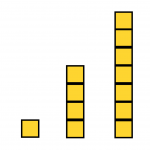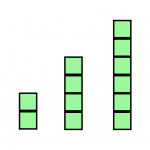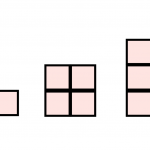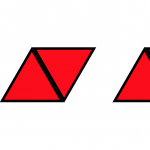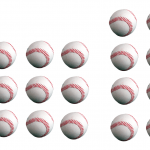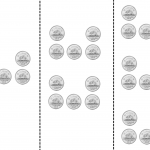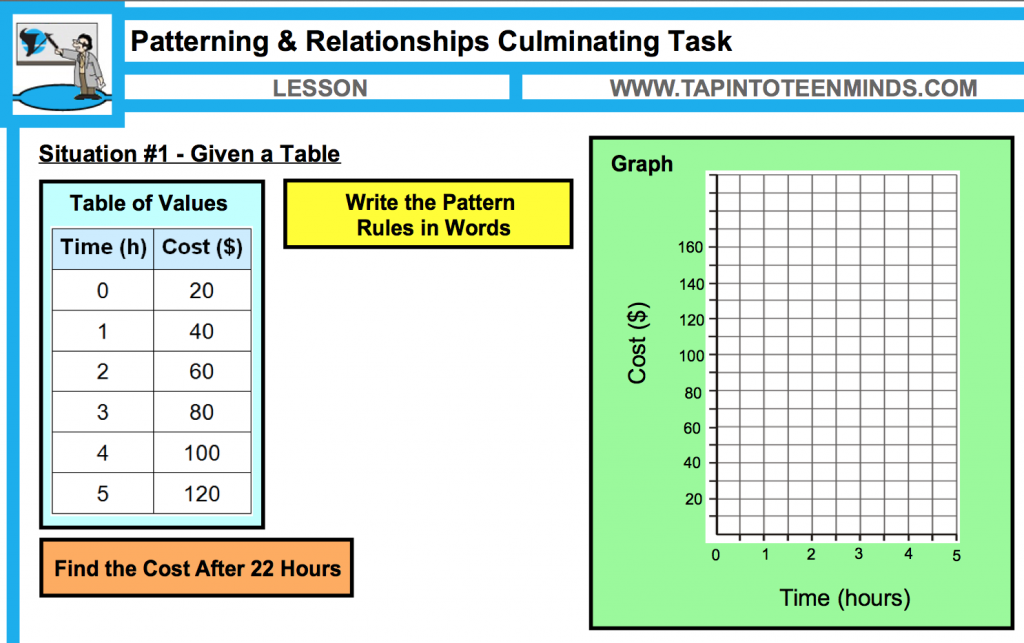Grade 6 Mathematics – Primary/Junior Resources
Grade 6 is a step up in difficulty for students. This is why they need support from resources like a math interactive notebook they can use or even just more tutoring. It’s also important to set goals for both you and the student.
Goals for this Course:
The goals for this grade 6 mathematics course include:
- learning mathematics through real world problem solving in a fun and engaging manner,
- gaining a deep understanding of the big ideas in mathematics by building a strong cooperative learning math talk community, and
- increasing the confidence of the student in mathematics to raise parent/public confidence in the Ontario education system.
Learning Goals for this Unit:
The learning goals for this grade 6 mathematics Patterns and Relationships unit for students are to:
- gain a deep understanding of geometric patterns through investigation,
- represent geometric patterns with words, a table and a graph,
- determine a term, given its term number by extending growing and shrinking patterns.
Student Questions & Prior Knowledge:
In order to assess student prior knowledge of patterns and relationships, the teacher will create different heterogeneous groupings of students based on level and assign a different pattern to each group. The groups will then be asked to have a discussion in their group about the pattern(s) assigned:
Pretend that you are communicating with your group via telephone. How would you describe the pattern you see?
Use these guiding questions:
- What does it look like?
- Is it growing or shrinking?
- What can you say to other group members that would allow them to recreate the pattern without actually seeing it?
Patterns That Could Be Used:
After 5 minutes of discussion, the groups will then share their pattern(s) to the rest of the class in an attempt to have the other groups recreate the pattern they are describing.
Principle from the 12 Principles of Teaching for Quality Learning Emphasized:
The Principles of Teaching for Quality Learning I will emphasize during this unit are:
- 5. Promote talk which is exploratory, tentative and hypothetical.
- 12. Promote assessment as part of the learning process.
While all 12 principles are very important to emphasize in the classroom, I believe that creating a math talk community is very important to maintain the engagement level of students and to make students accountable by providing opportunities for them to think deeply and defend their mathematical beliefs (right or wrong). By assessing daily and promoting these assessments as part of the learning process, students are motivated to remain an active participant of the classroom. This approach to assessing indicates to the student that assessments are not just a tool to determine who has a deep understanding, but rather to allow for every student to take next steps to deepen their own mathematical thinking.
Resources:
Resources will vary from iPad technology for investigations, individual tasks and journaling, as well as for minds on/consolidation clicker-type assessment activities to determine entry points as well as how deeply students understand a new concept. Group work will be completed using the Baiboard Collaboration app if completed digitally or on chart paper for placemat activities/bansho. Concrete and digital manipulatives will always be promoted on a daily basis for use when investigating and completing tasks.
Expectations Explored During This Unit:
- identify geometric patterns, through investigation using concrete materials or drawings, and represent them numerically;
- make tables of values for growing patterns, given pattern rules in words (e.g., start with 3, then double each term and add 1 to get the next term), then list the ordered pairs (with the first coordinate representing the term number and the second coordinate representing the term) and plot the points in the first quadrant, using a variety of tools (e.g., graph paper, calculators, dynamic statistical software);
- determine the term number of a given term in a growing pattern that is represented by a pattern rule in words, a table of values, or a graph (Sample problem: For the pattern rule “start with 1 and add 3 to each term to get the next term”, use graphing to find the term number when the term is 19.);
- describe pattern rules (in words) that generate patterns by adding or subtracting a constant, or multiplying or dividing by a constant, to get the next term (e.g., for 1, 3, 5, 7, 9, …, the pattern rule is “start with 1 and add 2 to each term to get the next term”), then distinguish such pattern rules from pattern rules, given in words, that describe the general term by referring to the term number (e.g., for 2, 4, 6, 8, …, the pattern rule for the general term is “double the term number”);
- determine a term, given its term number, by extending growing and shrinking patterns that are generated by adding or subtracting a constant, or multiplying or dividing by a constant, to get the next term (Sample problem: For the pattern 5000, 4750, 4500, 4250, 4000, 3750, …, find the 15th term. Explain your reasoning.);
Lesson #1: Identifying & Representing Geometric Patterns
| Lesson Features | Details |
|---|---|
| Topics | The learning goals for this lesson include having students identify geometric patterns and represent these patterns numerically, through investigation. |
| Expectations | identify geometric patterns, through investigation using concrete materials or drawings, and represent them numerically; |
| Learning Activities & Pedagogical Approach | This lesson will be led using the three-part lesson approach.
Minds On:
Pairs will share out with the class to communicate their understanding verbally. Action: Consolidation: |
| Assessment | The teacher has multiple opportunities for assessment via observation in the Minds On and Action sections due to the class discussions led during this portion. Collecting the Ticket Out The Door also offers an opportunity for the teacher to record formative assessment data by evaluating each student’s ability to represent a geometric pattern. |
| Modifications | Making modifications appropriate for the specific students in your class are a necessary addition to this lesson. A suggestion for a student working at a grade level below grade 6 would be to have a very basic pattern as an option for that student to attempt. For gifted students or students achieving at a higher level than most, a more complex pattern or asking the student to create their own pattern for the consolidation Ticket Out The Door would an option. |
| How is This Linked to Culminating Activity? | Students must be able to identify geometric patterns in the culminating task questions. |
Lesson #2: Representing Patterns in a Table of Values and Graphing
| Lesson Features | Details |
|---|---|
| Topics | The learning goals for this lesson include having students take a pattern rule in words, create a table of values and graph the coordinates on a grid. |
| Expectations | make tables of values for growing patterns, given pattern rules in words (e.g., start with 3, then double each term and add 1 to get the next term), then list the ordered pairs (with the first coordinate representing the term number and the second coordinate representing the term) and plot the points in the first quadrant, using a variety of tools (e.g., graph paper, calculators, dynamic statistical software); |
| Learning Activities & Pedagogical Approach | This lesson will be led using the three-part lesson approach.
Minds On – Think, Pair, Share:
Pair Share The teacher may ask volunteers to share the pattern created by their partner, to ensure that each student has gained an understanding of each pattern created. Action: Each set of pattern rules in words might have instructions such as this:
Once each pair has completed their task, the teacher will number off each pair. If there are 10 pairs, the teacher will number the pairs 1 to 5. Pair #1’s will group together at a table and share their work with the other pair and visa versa. Each pair will have the task of assessing the completed task of the other and provide peer feedback to make any required changes. Consolidation: |
| Assessment | The teacher will circulate the class during all portions of the lesson and take photos with an iPad inside each student’s Evernote Assessment Notebook that is shared with each student. This not only allows the teacher to keep a record and documentation of the student work and assess their understanding of the big ideas from this lesson. |
| Modifications | Making modifications appropriate for the specific students in your class are a necessary addition to this lesson. Similar to the previous lesson, having a basic set of pattern rules in words for students working at a grade level below grade 6 as well as having more difficult set of pattern rules or allowing for students to create their own set of pattern rules in words for gifted or high achieving students would an appropriate approach. |
| How is This Linked to Culminating Activity? | Students will be required to represent different patterns in a table of values as well as in a graph. |
Lesson #3: Finding Term Number Given Term Value
| Lesson Features | Details |
|---|---|
| Topics | The learning goals for this lesson include finding the term number of a given term in a variety of situations including: pattern rules in words, tables of values, and graphs. |
| Expectations | determine the term number of a given term in a growing pattern that is represented by a pattern rule in words, a table of values, or a graph (Sample problem: For the pattern rule “start with 1 and add 3 to each term to get the next term”, use graphing to find the term number when the term is 19.); |
| Learning Activities & Pedagogical Approach | This lesson will be led using the three-part lesson approach.
Minds On – Relay Race When the relay begins, a student from each group will go to the board to get their first card. Each card will have a different representation of a unique geometric pattern on it (pattern rules in words, tables of values, and graphs). In their group, students will work together to find the term number of a term value indicated on their card. Once the students have found the corresponding term number for that term value and have shown the method they used to find it, they will stick the completed task on the board under their group column and grab the next card. Students will compete in a friendly math game to complete all of the cards listed on the board. Each group will have to present their pattern cards and explain what they did to find the corresponding term number to the required value on the card. Action: Consolidation: |
| Assessment | The teacher has many assessment options during this lesson for assessing learning skills such as collaboration and self regulation during the group activities. A formative assessment could be recorded by collecting the cards created by each group at the end of the consolidation. |
| Modifications | Making modifications appropriate for the specific students in your class are a necessary addition to this lesson. While every student has different learning needs and modifications may be required based on those unique needs, ensuring there are pattern cards in both the relay race that vary in difficulty level is important. Heterogenous groupings can allow for weaker students to gain a deeper understanding of the concepts. Homogeneous groupings can also allow for an opportunity to create sets of pattern cards for the relay race that are appropriate for that grouping of students. |
| How is This Linked to Culminating Activity? | Students will be required to identify term values corresponding to term numbers as well as give pattern rules in words for the culminating task. |
Lesson #4: Representing Patterns Using Rules in Words
| Lesson Features | Details |
|---|---|
| Topics | The learning goals of this lesson include understanding the pattern rules in words that create patterns by adding, subtracting, multiplying or dividing a constant. |
| Expectations | describe pattern rules (in words) that generate patterns by adding or subtracting a constant, or multiplying or dividing by a constant, to get the next term (e.g., for 1, 3, 5, 7, 9, …, the pattern rule is “start with 1 and add 2 to each term to get the next term”), then distinguish such pattern rules from pattern rules, given in words, that describe the general term by referring to the term number (e.g., for 2, 4, 6, 8, …, the pattern rule for the general term is “double the term number”); |
| Learning Activities & Pedagogical Approach | This lesson will follow the three-part lesson format.
Minds On: Students will then share-out in their groups with group members suggesting ways in which their peers can improve their pattern rules. Once all groups have discussed each member’s pattern rules, the groups will then split up to discuss with members of other groups according to a system specified by the teacher. Action: Consolidation: |
| Assessment | The teacher can assess student learning skills and understanding as the class works throughout the Minds On and Action portion of the lesson, easily documenting their progress using Google Drive Spreadsheets as well as Evernote. The student work collected via Google Drive Forms during the consolidation can also be used for assessment purposes and can assist in gauging where to begin the next day. |
| Modifications | Ensuring there are an appropriate number of varying patterns for students achieving below, at and above the provincial standard will allow for all students to experience success and confidence throughout the lesson. |
| How is This Linked to Culminating Activity? | Students will be required to represent their patterns using rules in words both verbally and written. |
Lesson #5: Extending Patterns to Find Term Numbers and Term Values
| Lesson Features | Details |
|---|---|
| Topics | The learning goals of this lesson include understanding how to extend patterns to find the term of a particular term number. |
| Expectations | determine a term, given its term number, by extending growing and shrinking patterns that are generated by adding or subtracting a constant, or multiplying or dividing by a constant, to get the next term (Sample problem: For the pattern 5000, 4750, 4500, 4250, 4000, 3750, …, find the 15th term. Explain your reasoning.); |
| Learning Activities & Pedagogical Approach | This lesson will follow a three-part lesson format.
Minds On: Action: A student recorder could use their iPad (or chart paper) to document the different approaches that can be displayed in the classroom. Consolidation: |
| Assessment | The teacher will continue to record observations and descriptive feedback using Google Drive Spreadsheets.
The students can also share their Explain Everything videos with the teacher for an additional assessment opportunity as well as a chance for the teacher to provide descriptive feedback in their Shared Dropbox Folders. |
| Modifications | Similar to previous lessons, the teacher will have patterns of varying difficulty for students performing below and above the expectations for the grade 6 mathematics curriculum. Having pre-determined groupings is another modification that could be used to ensure certain heterogeneous or homogeneous groupings are used instead of using the Mix to the Music activity in the Minds On section. |
| How is This Linked to Culminating Activity? | The culminating task will require students to extend their growing and shrinking geometric patterns to find term numbers and corresponding term values. |
Patterning and Relationships Culminating Task
The culminating task attempts to bring the Big Ideas from the Grade 6 Patterning and Relationships unit into meaningful tasks that the students can complete to show they have gained a deep understanding.
Additional Resources for this Unit
Identifying Geometric Patterns – Grade 6 Patterning and Algebra
Geometric Patterning with Toothpicks Part 1
Geometric Patterning with Toothpicks Part 2
Growing Geometric Pattern – Create Table, Coordinates and Graph of Patterns

